SEO (Search Engine Optimization) for IT companies means improving a company’s website and digital footprint to achieve higher rankings on search engines such as Google, Bing, and DuckDuckGo. By doing so, IT firms can attract more relevant traffic, strengthen their online presence, and convert search interest into business leads.
A strong SEO strategy helps these companies appear in front of potential clients at the right moment — when they’re searching for tech services, software solutions, or trusted IT providers — building both visibility and credibility.
In this article, we’ll share with you six tips on how to apply SEO in a way that works in the competitive tech niche. You’ll learn how to build a strategy that draws in qualified leads, supports long-term growth, and gives your company a more reliable lead generation strategy than paid ads or cold outreach.
- SEO for tech differs from other niches and requires an approach that accounts for longer sales cycles and a technical audience.
- In contrast to the short-term benefits of PPC ads, the results from SEO are more consistent and compound over time.
- To compete in the tech niche, it’s best to start with keywords that are easier to rank for and gradually build your website authority from there.
- Breaking content into clusters based on use cases, integrations, or tools helps IT companies improve topical relevance and SEO rankings.
- Original content, expert guest posts, and partner mentions are all valuable backlink opportunities that can strengthen credibility and drive referral traffic.
Why SEO for IT and Tech Industries Requires a Unique Strategy
In a saturated tech space, SEO is still one of the most effective ways to get found on Google, which holds 89.79 percent of the global search engine market. But ranking in this space doesn’t work the same way it might for ecommerce or local businesses. Let’s look at the four main reasons why that’s the case:
Bigger Competition from Companies Already Doing SEO
You’re not the only one investing in content and technical improvements. A lot of IT competitors already have expert teams who optimize their pages. So, you’ll need more than a basic strategy to compete. Think original content, backlinks from authoritative sites, and a better understanding of a user’s path.
Longer Decision Cycles That Need More Than One Page
Most buyers aren’t ready to convert after a single visit. They need a mix of content that educates them, shows real-world use cases, and gives them enough reasons to choose you. Each one supports a different part of the buyer’s journey from research to conversion.
Technical Audience with High Expectations
Prospects in the IT space are often highly knowledgeable about technology and expect the information on your site to be accurate and helpful. If you write only for SEO, your content won’t satisfy their needs and may quickly drive them to your competitors.
Of course, SEO for IT websites isn’t the only digital marketing channel that brings in leads. Many IT companies also use paid ads to attract new visitors to their sites quickly. However, if we look at the difference between PPC and SEO, we can see that their outcomes aren’t the same.
With SEO, you invest time in optimizing your pages, creating expert content, and building links. But once that’s done, your website continues generating traffic and leads.
PPC, on the other hand, only works as long as you keep paying for each click. This makes search engine optimization often a stronger long-term investment that builds brand awareness and website trust and helps businesses grow over time.
6 SEO Tips for Tech Companies
Now that we’ve looked at why your strategy needs a more specific direction in the IT space, let’s get practical. Below, we’ll share with you six SEO tips for tech companies to make your site perform better in search.
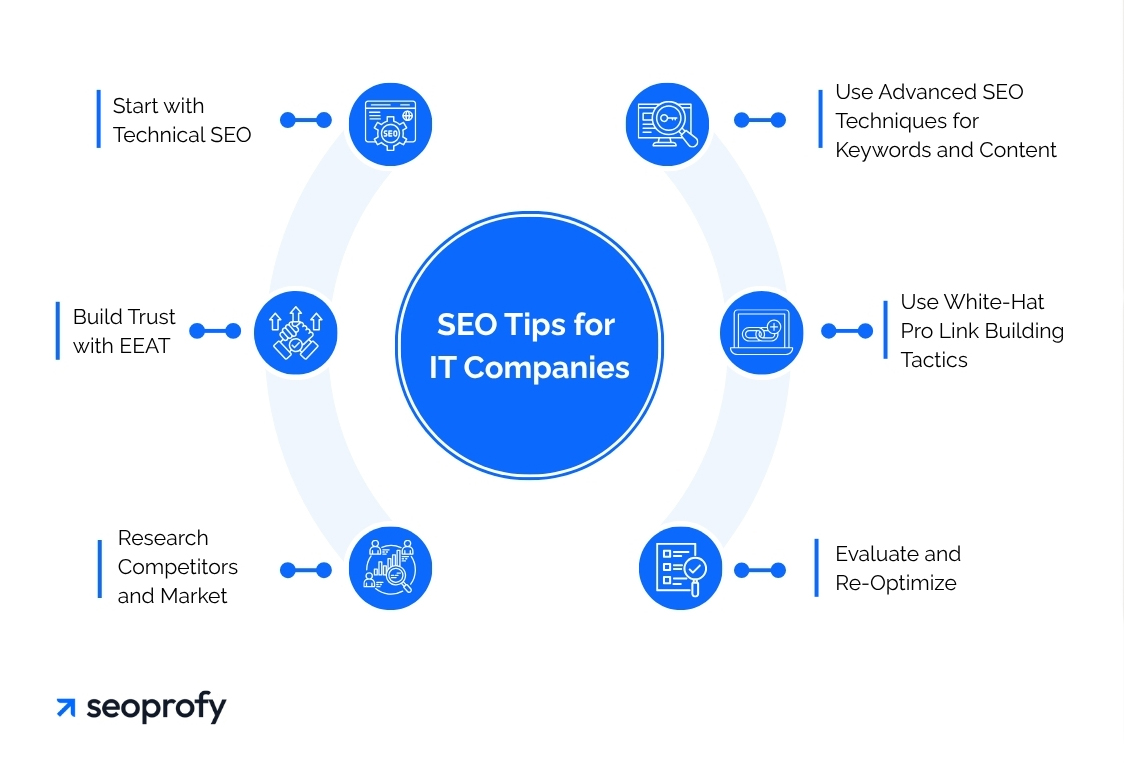
1. Start with Technical SEO Foundation
Technical SEO often gets overlooked, but for IT websites, it’s one of the first things worth checking. Many of your visitors come from organic search, and your site should provide the best possible user experience so they can stay longer and engage with your content. That includes everything from how fast your pages load to whether your meta descriptions match what’s on the page.
At the same time, search engine bots need to be able to find, crawl, and index your site properly. Otherwise, your pages won’t surface in Google’s search results or get found online.
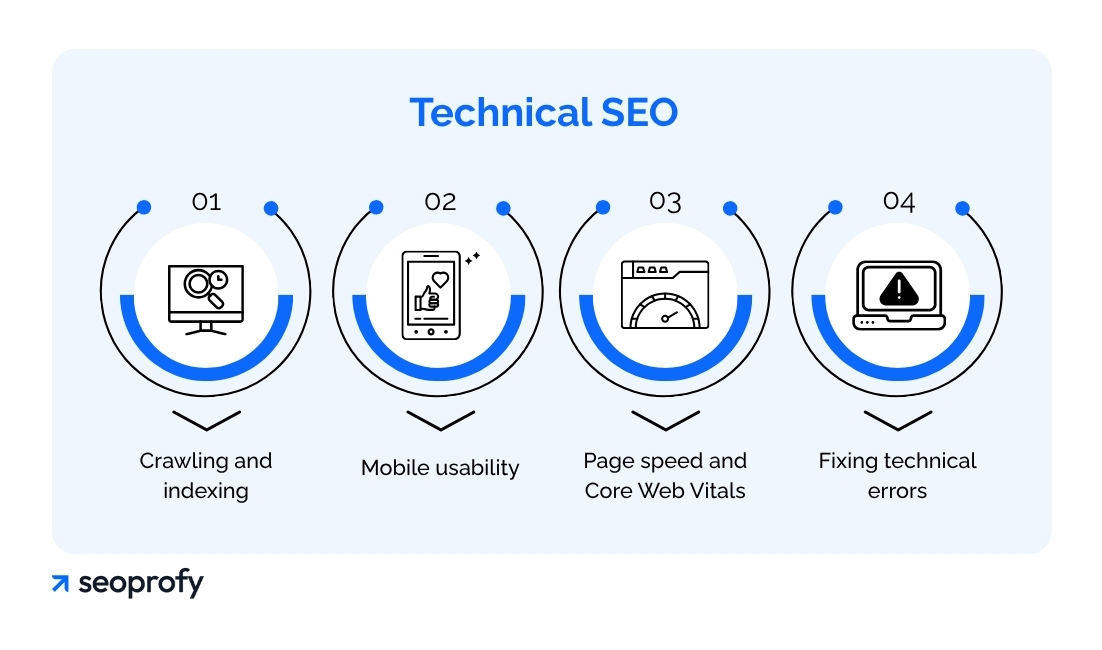
In our guide on technical SEO for SaaS (which overlaps a lot with IT), we went over the entire process of how to make your site technically optimized. Below is a summary of key areas to monitor:
- Mobile usability. Google indexes your mobile version first, and most people browse on their phones, too. Use the Mobile Usability report in GSC to check how your site works on smaller screens and make changes if needed.
- Page speed and Core Web Vitals. Fast-loading pages not only improve user experience but are also a key ranking factor. Google uses a set of metrics called Core Web Vitals to measure how real users experience the speed, responsiveness, and visual stability of a site. You can run your site through PageSpeed Insights or Google Search Console’s Core Web Vitals report to analyze your scores and identify issues like unoptimized images, script delays, or layout shifts.
- Crawling and indexing. For your pages to show up in SERPs, they should be accessible to search engine bots. To check if all your important pages are being processed, use the Indexing report in Google Search Console.
Generally, technical SEO is not something you do just once. It’s a continuous process of optimizing your site to help your visitors have the best browsing experience and make sure all your key pages are reachable and indexed by search engines.
On that note, let’s move to something just as important as the technical side — the credibility markers your site gives off. Your prospects pay attention to them, and Google does too.
2. Build Trust with EEAT
EEAT stands for Experience, Expertise, Authoritativeness, and Trustworthiness. It is part of Google’s Search Quality Evaluator Guidelines, not a direct ranking factor. It influences rankings through signals, not by being an algorithmic factor.
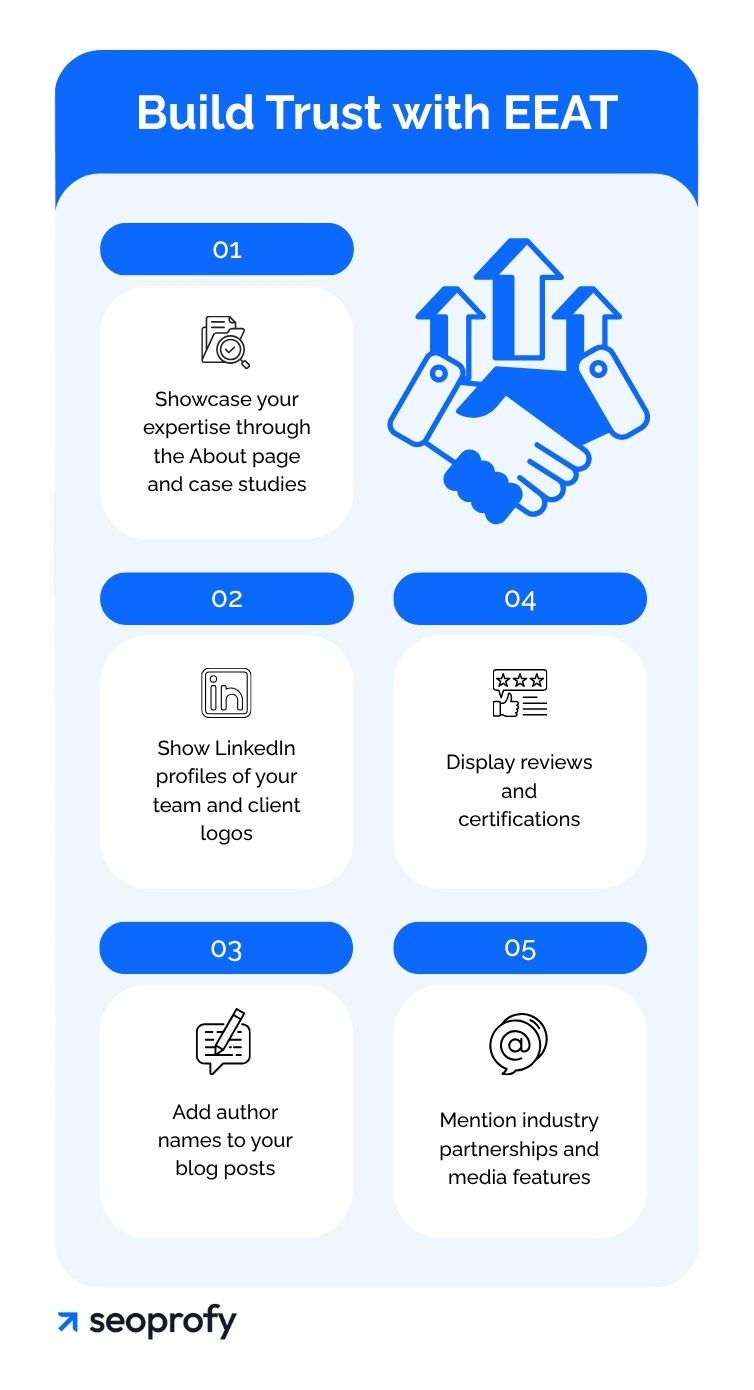
In SEO, these signals affect both your rankings and how people perceive your brand. The more of them you show on your site, the better the first impression it creates when someone lands on it. People can quickly see who you are, what you do, and what makes you an expert. There are a few simple ways to bring those signals forward:
- Add an About page, where you mention your background and describe the kind of work you do.
- Show the real people behind your company, with links to their LinkedIn profiles.
- Add short case studies that explain what the problem was and how you solved it.
- Show logos of companies you’ve worked with (if you’re allowed to).
- Add author names to your blog posts, ideally someone with experience in the field.
- Collect and display reviews, even short ones, on your main pages.
- Mention any industry partnerships, certifications, or media features.
If you’re not sure how to position your expertise or where to place the reviews, other websites in the tech space can be a good starting point, which leads us to our next section.
3. Research Competitors and Market Trends
Before you get to work on your own site, it makes sense to analyze your competitors in the niche who already rank at the top. They’ve already invested time in SEO strategies for IT companies and most certainly found tactics that help draw in prospects to their site.
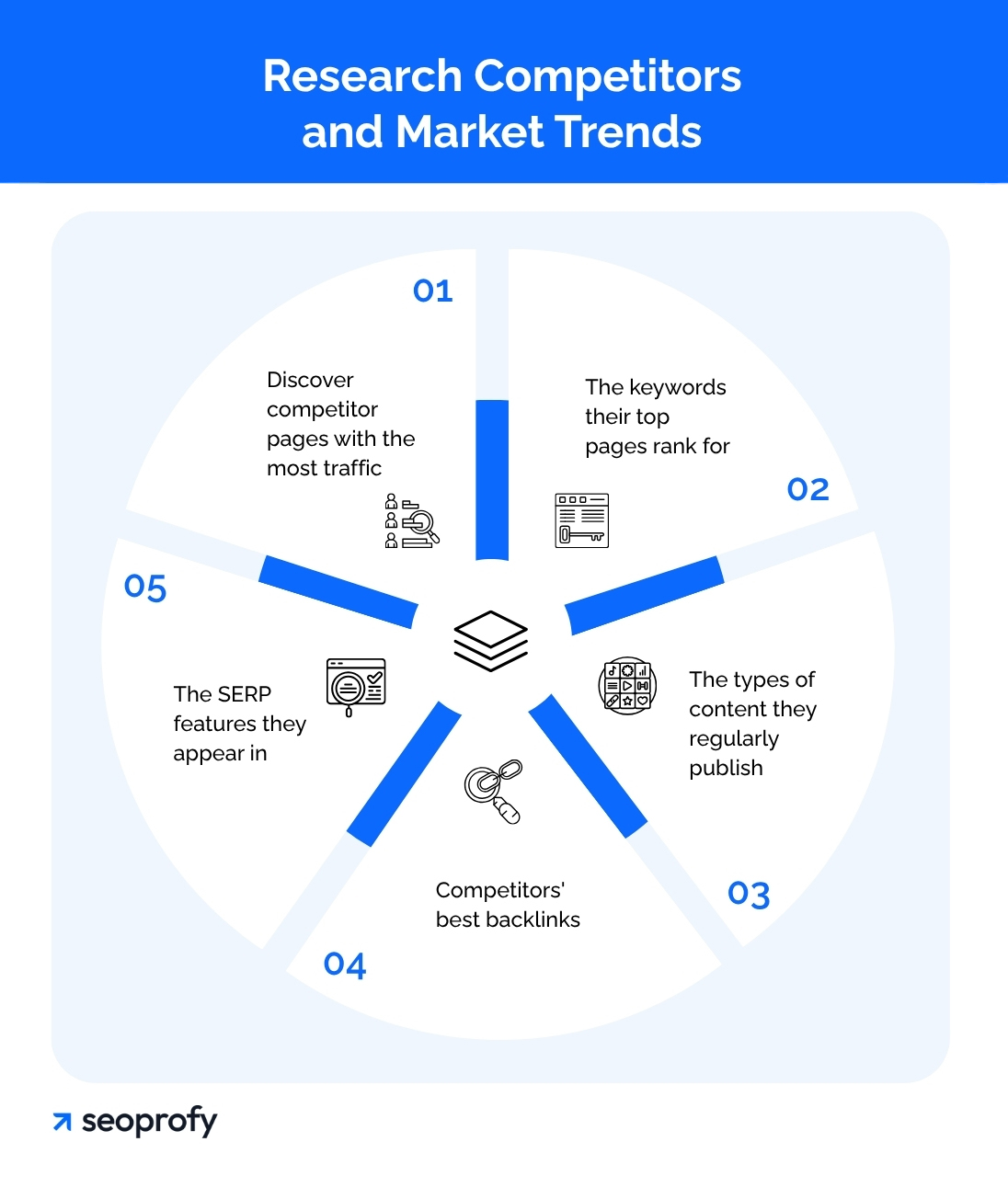
So instead of guessing what’s working, you can use some of the best SEO tools like Ahrefs or Semrush, to look at their sites and make a note of:
- The keywords their top pages rank for
- The types of content they regularly publish (e.g., blogs, case studies, landing pages)
- The trust signals they highlight, such as client logos, testimonials, and use cases
- The websites that link to their content and boost authority
- The SERP features they appear in — such as featured snippets, People Also Ask boxes, and image or video carousels. These show which content formats Google prefers for your target queries.
All this data gives you an idea of what people in your niche expect to find on your pages and what Google seems to rank well on SERPs.
This kind of research also helps you define your own edge or unique selling points. Maybe your company works in a more specialized segment, has more years of experience, or simply delivers better results. You can mention these USPs directly on your site to show your visitors from the very beginning how you compare to the competitors.
Our personalized SEO strategies are built for crowded markets like IT and help businesses:
- Rank for relevant keywords
- Bring in more qualified traffic
- Turn readers into prospects

4. Use Advanced SEO Techniques for Keywords and Content
The results you get from SEO often come down to the keywords you target and the content you create around them. Let’s look at how you can do both effectively:
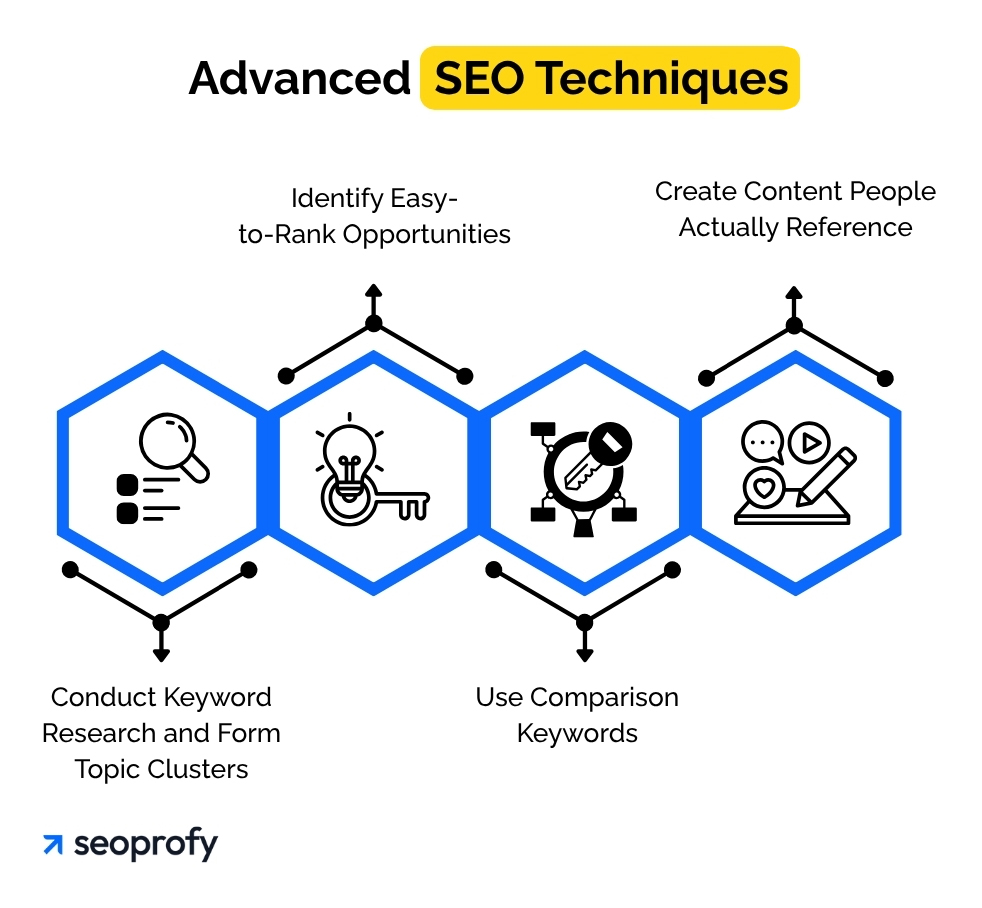
Conduct Keyword Research and Form Topic Clusters
In the IT space, where the competition is high, a well-planned keyword strategy can save you time and budget. The first thing you’ll want to do is start with broad research. Here are some of the tools (paid and free) you can use:
- Ahrefs or Semrush to see keyword ideas related to your product or services
- Google AutoSuggest to filter through long-tail phrases
- Keyword Planner to find relevant terms with commercial intent
- Answer the Public to learn common questions people ask
Using a mix of these tools gives you a dozen keyword ideas to work with, across informational, commercial, and bottom-funnel intent. Once you have a list of the queries, start building topic clusters.
In SEO for tech & IT companies, this helps organize complex topics, match different types of intent, and strengthen topical authority. Think of it as a main hub that covers a certain topic and smaller pieces that go into more detail.
The more in-depth you go with your clusters, the easier it is for Google and people to trust that you have the expertise in the space. It also supports long-term growth. You capture organic traffic across multiple points in the buyer journey.
Identify Easy-to-Rank Opportunities
You’ll often notice that ranking for broad, competitive terms in the IT space takes time. And unless you already have a strong domain, it rarely makes sense to start there. A smarter path is to look for terms that fewer businesses are targeting. Such phrases are more specific, easier to rank for, and still bring in qualified visitors.
You can find low competition keywords like this using the same tools from the previous steps. Type in your seed term and sort the list by low difficulty scores. Then scan for phrases that closely relate to your business (use cases, tech stack, or audience segment).
Use Comparison Keywords
If you sell software or any kind of IT service, chances are your audience is doing side-by-side research. These are called comparison keywords. And they’re often used by people who are further in the buying process, but haven’t decided on the vendor yet.
The value of these searches in SEO for IT is in the intent. Someone who types “X vs Y” isn’t browsing. They’re weighing options and looking for reasons to choose one over the other.
These are the pages that can bring in highly motivated visitors who are closer to booking a demo or bringing your name into a stakeholder meeting. To find these keywords, you can:
- Type your product or service into Google and add “vs,” “alternatives,” or “best for”.
- Use tools like Ahrefs or Semrush to filter for modifiers like “comparison,” “vs,” or “alternative.”
When you write pages that target these keywords, try not to be too salesy. A good comparison post lays out the facts, mentions both sides, and subtly positions your offer as the better choice for a specific audience or use case.
Create Content People Actually Reference
In competitive niches like IT, you also need to earn links from relevant industry blogs. The best way to do it is through posting high-quality content, one of the advanced SEO techniques that pays off long-term.
So, what makes other websites link to you? Usually, it happens when you share original, practical information that’s backed by experience. Think:
- Benchmarks based on your own product data
- Case studies with results and takeaways
- In-depth how-tos or frameworks your team uses internally
These are the pieces that get noticed when others are writing content and looking for sources to link. If your article helps them explain a concept or back up a point, it earns a place on their websites, too.
5. Use White-Hat Pro Link Building Tactics
Backlinks (links from other websites to yours) are still one of the strongest ranking factors in SEO for IT and technology industries. We’ve already reviewed one of the methods to land such mentions organically, so now let’s look at the other white hat SEO tactics to get links that reinforce your relevance in the industry.
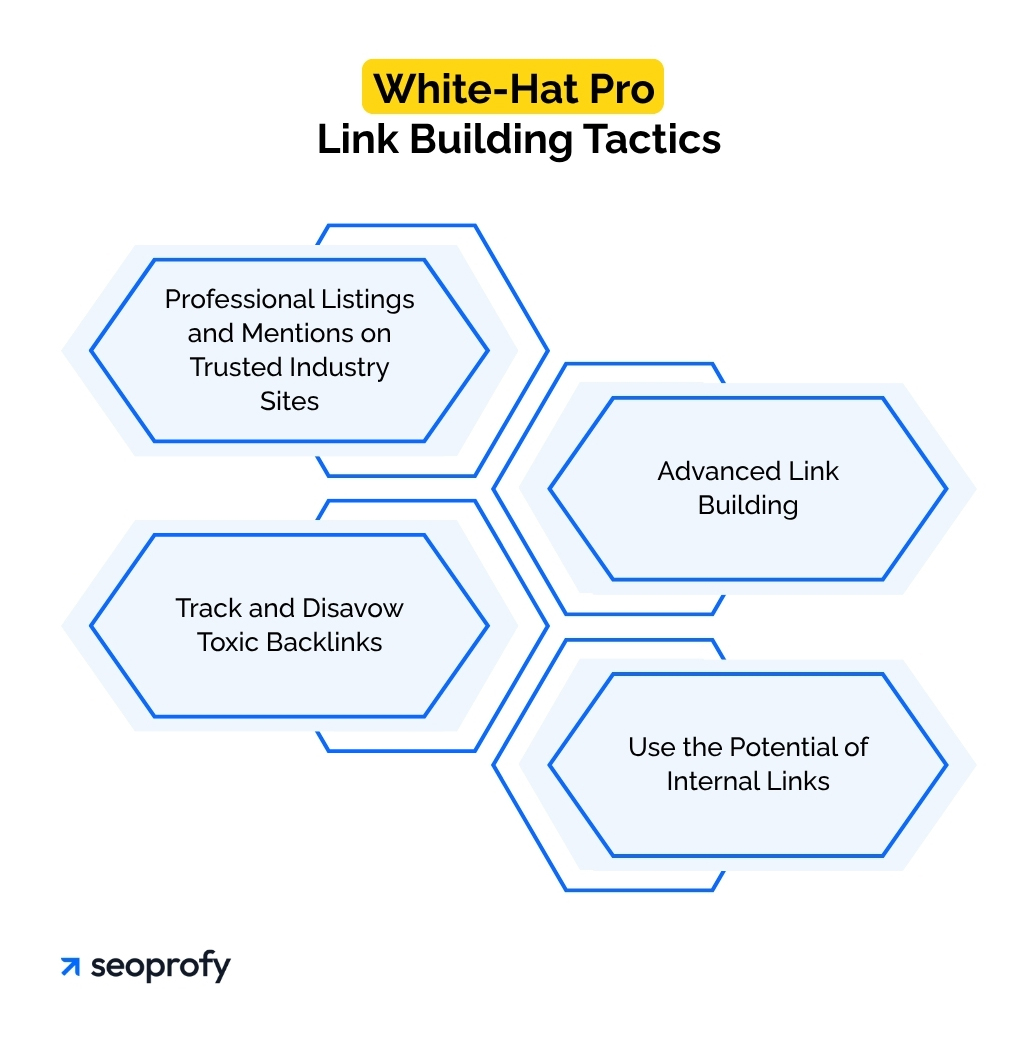
Professional Listings and Mentions on Trusted Industry Sites
The first place to start is with platforms that already hold authority in your space. These aren’t hard to find, but they are often skipped in favor of chasing “big” publications. Instead, think about where your potential customers or peers might look for software, tools, or partners. Here are a few opportunities to think about:
- Niche directories. These could be marketplaces like StackShare, cloud partner directories, or platforms where developers compare software. They send strong topical signals and often stay online for years.
- Clutch and similar B2B platforms. Such websites are useful for both visibility and credibility. Many buyers check them before reaching out, and each listing also gives you a valuable backlink.
- Guest content on respected blogs. The technical knowledge is valuable, and blogs often look for experts who can contribute to their sites. You could offer hands-on advice or case-based insights that readers can learn from.
Advanced Link Building
Okay, you now have the idea of sources to get quality links, so now let’s go a step further and tap into less obvious, but often valuable opportunities for tech and SaaS link building.
- Get listed in roundup articles. Blog posts that review multiple tools often rank well for high-intent keywords.
- Find and claim unlinked brand mentions. People might already be talking about your company online. Brand24, a tool that is often used in online reputation management, can help surface those mentions.
- Share expert input for interview pieces. Many blogs feature expert takes on industry trends and are always looking for new voices. A short, insightful quote can earn you both visibility and a quality backlink.
Track and Disavow Toxic Backlinks
Backlinks are beneficial for your site, but not all of them. Some can be harmful. You might get a mention from a spammy directory or a link farm, and that doesn’t just look bad to Google; it can also trigger filters in search engine algorithms and prevent your best pages from performing.
For this reason, you’ll need to audit the links you’re getting regularly. If you outsource SEO, this task should be on your agency’s radar as well.
In case you find anything suspicious, add it to a disavow file and upload it through Google Search Console. It doesn’t guarantee anything, but it tells Google you’re distancing yourself from those links.
Pay extra attention if you’ve recently seen a drop in search engine rankings or traffic. Sudden dips can sometimes trace back to a wave of bad links. And the sooner you handle them, the easier it is to recover.
Use the Potential of Internal Links
One of the most underrated on-page SEO levers we haven’t talked about is your internal links. When used intentionally, they help distribute authority across your pages, keep users engaged longer, and move them from one topic to the next without dropping off.
Internal links also help Google better understand your site structure. They show how pages relate to each other and which ones deserve more attention.
In SEO for tech companies, this is especially important as the content often spans across features, use cases, and educational materials. Let’s look at some best practices for your internal links below:
- Link from high-traffic pages (like blog posts or guides) to your commercial pages
- Write descriptive anchor text that reflects the target page
- Refresh old posts by linking to your newer content
You don’t need any tools for this. A simple spreadsheet is enough to help you track what’s already linked. Over time, this creates a strong internal network that improves navigation and supports your SEO.
6. Evaluate and Re-Optimize
The final (and crucial!) step in every strategy is evaluation. That’s when you do regular check-ins to make sure your campaign results match the SEO goals you set in the beginning. Generally, here’s what you’ll need to track:
- Traffic from organic search and how it’s trending
- Drop-offs or gains in keyword rankings
- Appearance in AI views for main keywords
- The quality of backlinks you get and to which pages
- Your top and least-performing content
- Conversion rate (booked demos, form submissions)
You can then iterate your strategy based on what the data tells you to see even better results from your SEO efforts.
Final Thoughts
SEO for technology companies is a long-term game. The first results often take 3 to 6 months to appear and even longer for high-difficulty keywords. Effective SEO is iterative. Results grow with consistent evaluation, optimization, and adaptation.
At our data-driven SEO company, we’ve helped software and IT companies grow their reach and revenue with strategies personalized to their needs. If you want input on where to start or how to improve your current strategy, book a free strategy call. We’ll assess your site and offer strategic suggestions without obligation.













